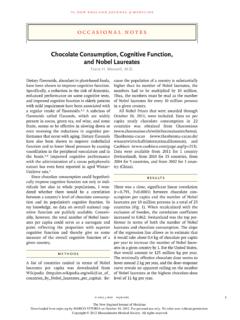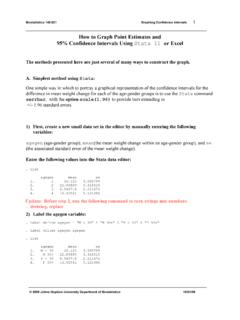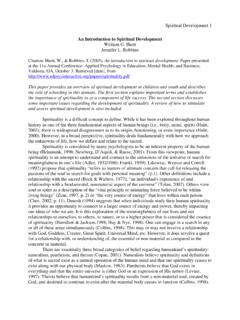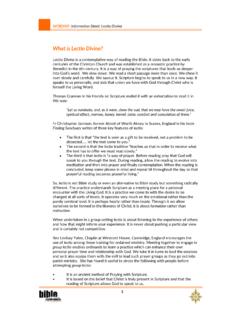Transcription of Lecture 1 Introduction to Multi-level Models
1 11 Lecture 1 Introduction to multi -levelModelsCourse web ~fdominic/teaching/bio656 Background on MLMs Main Ideas Accounting for Within-Cluster Associations Marginal & Conditional Models A Simple Example Key MLM components23 The Main Biological, psychological and social processes thatinfluence health occur at many levels : Cell Organ Person Family Neighborhood City Society An analysis of risk factors should consider: Each of these levels Their interactionsMulti-level Models Main IdeaHealthOutcome35 Example: Alcohol Abuse1. Cell: Neurochemistry2. Organ: Ability to metabolize ethanol3.
2 Person: Genetic susceptibility to addiction4. Family: Alcohol abuse in the home5. Neighborhood: Availability of bars6. Society: Regulations; organizations; social normsLevel:6 Example: Alcohol Abuse; Interactions betweenLevels5 Availability of bars and6 State laws about drunk driving4 Alcohol abuse in the family and2 Person s ability to metabolize ethanol3 Genetic predisposition to addiction and4 Household environment6 State regulations about intoxication and3 Job requirementsLevel:47 Notation:PopulationNeighborhood: i=1,..,IsState: s=1,..,SFamily: j=1.
3 ,JsiPerson: k=1,..,KsijOutcome: YsijkPredictors: XsijkPerson: sijk( y1223 , x1223 )8 Notation (cont.)59 Multi-level Models : IdeaPredictor VariablesAlcoholAbuseResponse Person s Income Family Income Percent poverty in neighborhood State support of the Rose is a Rose is Multi-level model Random effects model Mixed model Random coefficient model Hierarchical modelMany names for similar Models , analyses, and on Statistical Models A statistical model is an approximation to reality There is not a correct model ; ( forget the holy grail ) A model is a tool for asking a scientific question; ( screw-driver vs.)
4 Sludge-hammer ) A useful model combines the data with priorinformation to address the question of interest. Many Models are better than Linear Models (GLMs) g( ) = 0 + 1*X1 + .. + p*XpLog RelativeRiskLog Odds RatioChange inavg(Y) per unitchange in XCoef InterpPoissonlog( )Count/Timesto eventsLog-linearBinomial logBinary(disease)LogisticGaussian Continuous(ounces)LinearDistributiong( )ResponseModel ( = E(Y|X) = mean ) (1- )713 Since: E(y|Age+1,Gender) = 0 + 1(Age+1) + 2 GenderAnd: E(y|Age ,Gender) = 0 + 1 Age + 2 Gender E(y) = 1 Generalized Linear Models (GLMs) g( ) = 0 + 1*X1 +.
5 + p*XpGaussian Linear:E(y) = 0 + 1 Age + 2 GenderExample: Age & Gender 1 = Change in Average Response per 1 unit increase in Age, Comparing people of the SAME Linear Models (GLMs) g( ) = 0 + 1*X1 + .. + p*XpBinary Logistic: log{odds(Y)} = 0 + 1 Age + 2 GenderExample: Age & Gender 1 = log-OR of + Response for a 1 unit increase in Age, Comparing people of the SAME : log{odds(y|Age+1,Gender)} = 0 + 1(Age+1) + 2 GenderAnd: log{odds(y|Age ,Gender)} = 0 + 1 Age + 2 Gender log-Odds = 1log-OR = 1815 Generalized Linear Models (GLMs) g( ) = 0 + 1*X1 +.
6 + p*XpCounts Log-linear: log{E(Y)} = 0 + 1 Age + 2 GenderExample: Age & Gender 1 = log-RR for a 1 unit increase in Age, Comparing people of the SAME : Verify Tonight16D. Responses are independentB. All the key covariates are included in the model Quiz : Most Important Assumptions ofRegression Analysis?A. Data follow normal distributionB. All the key covariates are included in the modelC. Xs are fixed and knownD. Responses are independent917 Non-independent responses(Within-Cluster Correlation) Fact: two responses from the same familytend to be more like one another than twoobservations from different families Fact: two observations from the sameneighborhood tend to be more like oneanother than two observations from differentneighborhoods Why?
7 18 Why? (Family Wealth Example)GODG randparentsParentsYouGreat-GrandparentsG reat-GrandparentsYouParentsGrandparents1 019 Key Components of Multi-level Models Specification of predictor variables from multiplelevels (Fixed Effects) Variables to include Key interactions Specification of correlation among responsesfrom same clusters (Random Effects) Choices must be driven by scientificunderstanding, the research question andempirical (within-cluster associations)1121 Multi-level analyses Multi-level analyses of social/behavioralphenomena: an important idea Multi-level Models involve predictors frommulti- levels and their interactions They must account for associations amongobservations within clusters ( levels ) to makeefficient and valid with Correlated DataMust take account of correlation to: Obtain valid inferences standard errors confidence intervals Make efficient inferences1223 Logistic Regression Example:Cross-over trial Response: 1-normal; 0- alcohol dependence Predictors: period (x1).
8 Treatment group (x2) Two observations per person (cluster) Parameter of interest: log odds ratio ofdependence: treatment vs placeboMean model : log{odds(AD)} = 0 + 1 Period + 2 Trt24 Results: estimate, (standard error) ( ) ( ) ( )Ordinary ( ) ( ) ( ) InterceptAccount forcorrelationVariableSimilar Estimates,WRONG Standard Errors (& Inferences) for OLR( 0 )( 2 )( 1 )1325 Simulated Data: Non-ClusteredCluster Number (Neighborhood)Alcohol Consumption (ml/day)26 Simulated Data: ClusteredCluster Number (Neighborhood)Alcohol Consumption (ml/day)1427 Within-Cluster Correlation Correlation of two observations fromsame cluster = Non-Clustered = ( ) / = 0 Clustered = ( ) / = Var - Var Within Tot Var28 Models for Clustered Data Models are tools for inference Choice of model determined by scientific question Scientific Target for inference?
9 Marginal mean: Average response across the population Conditional mean: Given other responses in the cluster(s) Given unobserved random effects We will deal mainly with conditional Models (but we ll mention some important differences)1529 Marginal vs Conditional Models Focus is on the mean model : E(Y|X) Group comparisons are of main interest, with high alcohol use with low alcohol use Within-cluster associations are accounted forto correct standard errors, but are not of model Interpretations log{ odds(AlcDep) } = 0 + 1 Period + 2pl = + ( )Period + ( )plTRT Effect: (placebo vs.)
10 Trt)OR = exp( ) = , 95% CI ( , )Risk of Alcohol Dependence is almost twice as highon placebo, regardless of, (adjusting for), time periodSince: log{odds(AlcDep|Period, pl)} = 0 + 1 Period + 2 And: log{odds(AlcDep|Period, trt)} = 0 + 1 Period log-Odds = 2 OR = exp( 2 )WHY?32 Random Effects Models Conditional on unobserved latentvariables or random effects Alcohol use within a family is relatedbecause family members share anunobserved family effect : common genes,diets, family culture and other unmeasuredfactors Repeated observations within aneighborhood are correlated becauseneighbors share: common traditions,access to services, stress levels .















